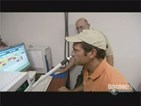Discovery Channel's Dirty Jobs Uses Microanalytics Aromatrax Technology To Get To The Bottom Of Diaper Odors

 Round Rock, TX - Microanalytics, a subsidiary of MOCON, was featured recently on the Discovery Channel's Dirty Jobs program. In the segment that premiered on November 27th, host Mike Rowe visited the facility to understand how analytical chemistry can help contain or neutralize the stench of aging, dirty diapers.
Round Rock, TX - Microanalytics, a subsidiary of MOCON, was featured recently on the Discovery Channel's Dirty Jobs program. In the segment that premiered on November 27th, host Mike Rowe visited the facility to understand how analytical chemistry can help contain or neutralize the stench of aging, dirty diapers.
Microanalytics AromaTrax GCMS-Olfactometry Systems, combined with the human nose, provides an accurate and efficient way to characterize and identify critical odors. Identifying the compounds that are causing malodors speeds the development of effective processing strategies for their removal. Typically, the company is contracted to identify the source of offending odors in a variety of products and situations and offers solutions to contain or neutralized them.
Taking a light-hearted approach to the topic, Rowe first spent time at a local daycare center collecting "the samples" before taking them to Microanalytics for analysis.
Microanalytics Founder Don Wright gave Rowe a tour of the labs and put him in front of the "sniff port" so that he could experience first hand how the odor identification process works.
First, two dirty diapers were wrapped tightly and then placed into a glass jar, which was sealed via a metal screw-on closure. The closure had a pinhole at the top into which a needle was inserted down into the vapor space above the diapers. The needle tip was exposed for 15 minutes to collect the sample. The sample was then transported to the AromaTrax® unit and heated to release individual compounds. A sniff port was used to detect and identify the malodorous compounds.
Four compounds — dimethyl sulfite, dimethyl trisulfide, methyl mercaptan and p-cresol — were identified as the principle odor causing components in the dirty diapers that were tested. To see if the malodor could be duplicated, liquid versions of each of the four compounds were combined in a separate container. Rowe visibly recoiled after having sniffed the new "cocktail," supporting the findings.
"This is relatively complex technology," says Wright. "In addition to the technology that has gone into the instrumentation, we also have developed ‘bookkeeping' software which allows analysts to react quickly to the compound presented by giving them a way to log their findings directly onto the computer screen. Speed is critical since analysts often only have a second or two to respond to one compound before the next one presents itself at the sniff port."
Although, the AromaTrax unit is capable of identifying thousands of compounds, typically only a small number are most responsible for causing the odor issues. It is the specific identification of those problem compounds that can assist manufacturers in creating improvement products for their containment.
"In this example, our goal is to help manufacturers optimize the film that is used to make garbage bags so that it forms a greater barrier to the specific odorants that are emitted by aged dirty diapers," Wright says.
In addition to selling AromaTrax units, Microanalytics also provides in-house testing and consulting services for companies who need rapid resolution of an odor quality problem. This is a valuable alternative for companies who do not have the luxury of ramping up internal capabilities (both labor and equipment investment) to solve an odor problem that has suddenly presented itself.
SOURCE: Microanalytics
